Book contents
- Frontmatter
- Dedication
- Contents
- List of tables and figures
- About the author
- Acknowledgements
- Introduction
- One A political ecology of youth
- Two The global crisis and the ‘age of austerity’
- Three Education and training: the broken promise
- Four Education and training: from public good to private responsibility
- Five Unemployment and work: precarious futures
- Six NEETs and the disengaged: the ‘new’ youth problem
- Seven Divergence and difference: contrasting cross-national experiences of being young
- Eight Education, work and welfare in diverse settings
- Nine Youth and mobility: inequality, leaving home and the question of youth migration
- Ten After the crisis: social change and what it means to be young
- References
- Index
Four - Education and training: from public good to private responsibility
Published online by Cambridge University Press: 01 September 2022
- Frontmatter
- Dedication
- Contents
- List of tables and figures
- About the author
- Acknowledgements
- Introduction
- One A political ecology of youth
- Two The global crisis and the ‘age of austerity’
- Three Education and training: the broken promise
- Four Education and training: from public good to private responsibility
- Five Unemployment and work: precarious futures
- Six NEETs and the disengaged: the ‘new’ youth problem
- Seven Divergence and difference: contrasting cross-national experiences of being young
- Eight Education, work and welfare in diverse settings
- Nine Youth and mobility: inequality, leaving home and the question of youth migration
- Ten After the crisis: social change and what it means to be young
- References
- Index
Summary
Introduction
In the previous chapter we explored the expansion of education and training, showing how it has become a central feature of young people's lives. Our case study analysis drew attention to the political processes that have shaped this area, highlighting how ‘third way’ politics has had a major impact on determining what was to be achieved. We explored the implications of the failure of the graduate promise alongside the limited opportunities provided by vocationalism and the implications for social mobility. This chapter continues this analysis. First, we will explore in more detail the way neoliberalism has changed the field of practice in post-16 education and training. While ‘third way’ politics brought a commitment to questions of social justice, neoliberalism was hugely influential in reshaping the way that universities and vocational education and training (VET) providers were to operate. This process has increased since the 2007 crisis as a result of austerity measures being implemented. Second, a major change brought about by neoliberal principles was the ‘user pays’ philosophy. While this approach has a long history in some countries, by the 21st century it was fully established in the post-16 educational and training sector and, as we shall see, since the crisis it has had substantial impacts on levels of student debt. The final section of this chapter will return us to the question of the widening participation agenda, where we will examine how effective it has been in the UK, Australia, Canada and New Zealand in bringing different social groups into the education and training field.
Neoliberalism and the commodification of education and Training
At the heart of the recent reforms in post-16 education and training has been the roll out and implementation of neoliberal approaches. These have had a significant impact on the educational experience of young people in Australia, Canada, New Zealand and the UK. When talking about higher education, ‘under neoliberalism, markets have become a new technology by which control can be effected and performance enhanced, in the public sector’ (Olssen and Peters, 2005, p.316). While these practices in the delivery of higher education can be seen in most advanced economies, the level and intensity of these processes varies by country and in some places by region (Marginson, 2013).
- Type
- Chapter
- Information
- Understanding Youth in the Global Economic Crisis , pp. 87 - 108Publisher: Bristol University PressPrint publication year: 2016

